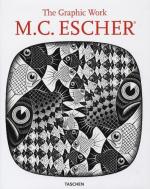|
This section contains 988 words (approx. 4 pages at 300 words per page) |

|
With his fantastically precise, yet hallucinatory and illusional imagery, graphic artist M.C. Escher became a favorite of students and those who indulged in chemically altered states in the 1960s. Escher was best known for his tessellation, or repeating geometric patterns, and he also liked to draw scenes that incorporated several different spatial perspectives. In the course of time, his work became some of the most recognizable in the art world. Today, decks of playing cards and T-shirts decorated with his distinctive black and white patterns are usually found in museum gift stores next to the Van Gogh items—somewhat ironic in that, during his lifetime, Escher was dismissed by the traditional arts establishment as "too cerebral."
Escher died in 1972, not long after the heady counterculture of the 1960s had elevated his art to iconic status. "The hippies of San Francisco continue...
|
This section contains 988 words (approx. 4 pages at 300 words per page) |

|


